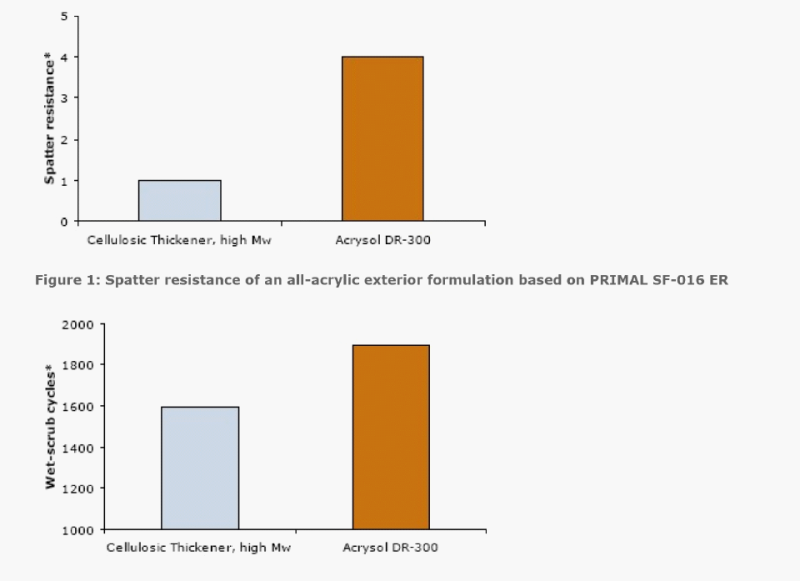Enhanced TDS
Identification & Functionality
- Chemical Family
- Function
- Thickener
- Industrial Additives Functions
- Product Code
- MITM11264
- Technologies
- Product Families
Features & Benefits
- CASE Ingredients Features
- Performance Highlights
- ACRYSOL DR-300 thickener provides application and "feel" properties very similar to those of medium and high-molecular-weight cellulosic thickeners with better leveling, sag resistance, and resistance to roller spattering in most formulations.
- A comparison of a high-molecular-weight cellulosic thickener and ACRYSOL
DR-300 in a 48% PVC/30% VS all-acrylic exterior formulation based on PRIMAL™ SF-016 ER emulsion illustrates the similarity in the key rheology properties they provide
Rheological properties 1% ACRYSOL™ DR-300 Viscosities after production 0,8 ICI Viscosities after production 108 KU Viscosities after production 27700 Brookfield Sp 4/6 rpm
Viscosities after equilibrium 0,7 ICI, 48 hrs Viscosities after equilibrium 110 KU, 48 hrs Viscosities after equilibrium 29800 Brookfield Sp 4/6 rpm, 48 hrs
Viscosities after heat aging 0,5 ICI, 10 days at 60°C
Viscosities after heat aging 108 KU, 10 days at 60°C
Viscosities after heat ageing 24800 Brookfield Sp 4/6 rpm, 10 days at 60°C
Spatter resistance Excellent Water resistance Excellent - Apart from the achieved benefit of lower formulated cost, Figure 1 and 2 show the superior resistance to roller spattering and the enhanced water resistance of ACRYSOL DR-300. In general, traditional synthetic thickeners based on acrylate increase the water sensitivity and therefore decrease the scrub resistance.
- The new technology generation provides superior scrub resistance compared to traditional synthetic thickeners.

Figure 2: Water resistance of an all-acrylic exterior formulation based on PRIMAL SF-016 ER
- Product Characteristics
- Good water resistance: Exterior durability
- Low-viscosity liquid: Easy to handle and incorporate during manufacturing
- Good flow/sag balance: Thicker films; good appearance
- Good paint consistency and stability: Thick, creamy "in-can" appearance with stable viscosity
- Synthetic: Resistant to microbial attack
- Excellent thickening efficiency, lower formulated cost
Applications & Uses
- Markets
- Applications
- Formulation Information
- When substituting any synthetic associative thickener for a cellulosic agent, the proper choice of dispersant, co-solvent, and surfactant is critical to achieving maximum performance properties and cost savings. While pure polyacid dispersants like OROTAN™ N-4045 are showing excellent compatibility with the DR-Technology, the usage of a hydrophobic copolymer dispersant is recommended with ACRYSOL DR-300 because of the superior exterior durability.
- Therefore OROTAN 731-A-ER, at a level of 0.80% solids on titanium dioxide/extender solids, has consistently promoted efficiency and general application performance. For optimum water resistance properties, the most suitable dispersant is OROTAN 165.
Properties
- Physical Form
Packaging & Availability
- Packaging Type
Principal Information
- Group Principal Number
- S000005
- Principal
Other
- Appearance
- Milky white liquid
- Color (SDS)
- Milky white
- Item Number
- Odor (SDS)
- Acrylic like
- Temperature Control
- No
- USA/DOT UN Number
- Not Applicable
- Chemical Properties
Value Units Test Method / Conditions pH 4.0-6.0 - as supplied - Material Composition
Value Units Test Method / Conditions Solid Content 17.5 % % - Physical Properties
Value Units Test Method / Conditions Density 1.04 g/cm³ g/cm³ at 25°C Viscosity 2000.0-7500.0 cPs cPs Brookfield Viscometer as supplied - SDS Physical and Chemical Properties
Value Units Test Method / Conditions Boiling Point (SDS) 100.0 °C °C at 760 mmHg, water Boiling Point (SDS) 100.0 °C °C Evaporation Rate (SDS) max. 1.0 % % Butyl Acetate=1 Evaporation Rate (SDS) max. 1.0 % % Butyl acetate = 1, water Melting Point (SDS) 0.0 °C °C Melting Point (SDS) 0.0 °C °C Water Relative Vapor Density (SDS) max. 1.0 - Air = 1, Water Relative Vapor Density (SDS) max. 1.0 - Air=1 Specific Gravity (SDS) 1.04 - Water = 1 Viscosity (SDS) max. 5000.0 mPa.s mPa.s Volatile Content (SDS) 81.0-84.0 % % pH (SDS) 4.0-6.0 - - Shelf Life & Stability
Value Units Test Method / Conditions Shelf Life 0.0 d d
